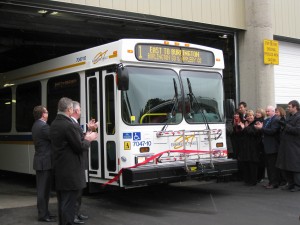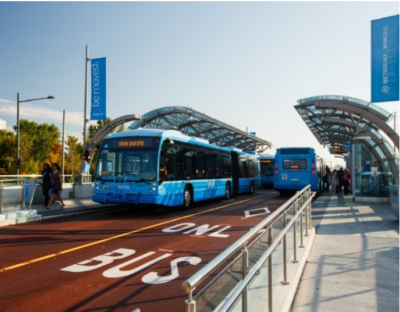 By Andrea Grebenc
By Andrea Grebenc
September 27th, 2022
BURLINGTON, ON
People are moving to Halton Region and expect interconnected communities. Candidate for Regional Chair Andrea Grebenc set out her position on local transit: It is long-past time for a regional public transportation model in Halton.
Burlington, Milton and Oakville each have their own public transportation system. Halton Hills public transportation does not exist. Halton is an increasingly integrated community. Residents don’t live, work and have fun only around home. They visit and commute to other parts of the region and beyond. As I’ve talked to people while canvassing on my journey to the Regional Chair role, I have noted that many people are asking for better transit. Halton is a growing region and many people are moving in from places outside Halton that have effective transit. They move to Halton and are disappointed to find that to effectively move around the region, a car is necessary. This contributes to growing gridlock and increases our carbon footprint. Living in Burlington and working in Milton(or vice versa) requires hours of convoluted public transportation commuting and involves leaving the region entirely within the journey. This is not attractive or effective.
Because of this growing interdependence of transportation between Halton communities public transportation should be uploaded to the Regional level.

Burlington Transit getting new buses
Integrated public transportation planning and interconnection not only within the Region, but between adjacent regions could make commuting a seamless endeavour across the Greater Toronto and Hamilton Area, freeing up time and improving quality of life. This makes good economic sense for people as commuters, and for businesses looking to expand into and within Halton. This is an especially attractive concept for people and businesses who are considering how to reduce their carbon footprint and increase environmental stewardship. Some business organizations may even decide to subsidize or purchase public transportation passes for employees as a benefit to demonstrate action on environmental concerns and a way to attract employees.
Many regions in the province have moved to a regional transportation system. Let’s look for best practices on how to implement this in Halton.

York Region is probably the most advanced transit system in the province -fully integrated
Along with public transit, active transit integration across the region should be strengthened. People are looking more and more at the climate and health benefits of this mode of transportation. We need to look at providing safe ways to make this happen.
The Regional Council unanimously approved a motion to declare a climate emergency in 2019 and strong improvements to public and active transportation would align with that position.
The municipalities within Halton have grown and matured, and the province has mandated that this growth continue. Services like police, public health, wastewater, water purification are already part of the Region’s mandate. Similarly, it makes sense for the Region to have a bigger role in providing public transit across the Region.

Andrea Grebenc: candidate for Halton Regional Chair
Andrea Grebenc is a registered candidate for Halton’s Regional Chair position in the upcoming municipal election and her name will appear on all ballots in Burlington, Halton Hills, Milton and Oakville. For more information about her experience, background, and platform, visit Andrea4Halton.ca.















A serious look at the idea would be warranted. Most places in Milton, Oakville and Halton Hills can be cycled to in less time than it takes to get there from Burlington with transit, it’s pathetic at the best of times and non-existent at the worst. But there are a couple of drawbacks to consider that should also be factored in. First is control over route planning. Oakville has built a grid system, which requires a very different philosophy and level of investment from Milton or Halton Hills which may not have the demand needed to support that.
Second is administrative overhead. At first glance, there would be some savings from sharing and standardizing buses & amalgamating management teams and support infrastructure. But the larger the system, the more overhead is needed to make decisions and the less responsive the system can be to its users. I’d be wary about giving power over transit to the Region, especially since their employees are largely out in the middle of nowhere off the highway, and very disconnected from everyday transit users. A regional version of Metrolinx is the last thing we need. But that Oakville system has already been expanded to a couple of places in Burlington (connecting to Appleby GO & the Dundas/407 Carpool lot) and similar connections that cross municipal lines would be a good addition to supplement frequent local transit on the core routes in each city. Nothing stopping the 4 munis from working together even if the Region doesn’t run it.
Another obstacle that needs creative solutions is how to effectively tie together the densely populated southern areas of Halton with the relatively sparse northwestern regions. This problem is endemic across the province and across the Country. Solve this one, add in working from home, and accommodating population growth becomes a much different issue.
Andrea makes a good point. an integrated transit system is better than a bunch of local systems. But, for example, what if you live in Oakville and work in Port Credit? Same problem. On the other hand, Burlington and Hamilton already have some interconnections thanks to our road situation, with buses that cross the borders. So maybe the answer is Provincial integration, like GO transit? Can the province be trusted to expand without bogging down in politics/special interests instead of realistic planning? (examples: Toronto, highway 413).
Anyway, new ideas are better than none, which is the usual offering..
I agree that it should move up to the region.
But is it possible to consider reducing the cost of using transit for those of us who are disabled or elderly? The amount we receive from ODSP makes it impossible to use public transit. I know there is an application that can be filed requesting a reduced fee but even that is beyond our meager budget. I would rather see a sliding scale be used instead. This scale could start at full cost for those with excellent income and go all the way down to zero for those on limited budgets like the elderly and the disabled. For many of us, car ownership is out of the question which means multiple trips a week to the grocery store, the food banks and soup kitchens.
How many elections has this been a hot topic 3 at least!
As mayor of Burlington, what would be your take on this proposal?